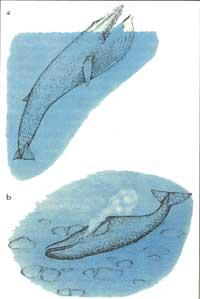The Xibarta Whale: the giant mammal singing
2001/06/03 Mendiburu, Joana - Elhuyar Zientziaren Komunikazioa

Singing? Yes, you have read well: whales, like humans and many other animals, sing. And today we dance to the rhythm of the songs of the Xibarta whale. The scientific name of the Xibarta whale is Megaptera novaeangliae, that is, the great wings of New England. In fact, the shares have pectoral fins of about 4.5 meters. The name learned from fishermen who came to hunt the whale is used: humpback whale. It is probably the name put by the arch shape that adopts the backrest when swimming. In Hawaii, finally, the entire whale category is known as "kohola" and there is no special name for the tojo whale.
The Xibarta whale is the fifth largest in the world. Newborns have an approximate weight of 1.5 tons and a length of between 3 and 5 meters. The adult males of the northern hemisphere are between 12 and 16 meters long and those of the southern hemisphere can reach 18 meters in length. Females, on the other hand, are somewhat longer. On the other hand, the average weight of adults ranges between 35 and 40 tons. According to the researchers, the Xibarta whale can live between 40 and 60 years. As indicated, most of the body is black grey, except for fins, chest, belly and inside tail fins. In total there are three isolated populations: north of the Pacific Ocean, north of the Atlantic and south of the southern hemisphere. In general, they feed well in summer and in winter they migrate and reproduce in breeding areas.

The warm waters of the coast between Alaska and California traverse the summer about 10,000 specimens. In the cold months between November and May, most migrate to temperate waters in Hawaii, Mexico, Costa Rica and Japan, where they reproduce, breed and care for newborns. The rest, off the coast of Baja California, are wintering in Mexico and the islands of southern Japan. Meanwhile, the southern hemisphere abutments spend the summer (from November to May) in Antarctica and the winter (from June to October) in eastern Australia and in the southern Pacific islands, where they reproduce.
As has been said, most of the jibartas breed and breed around Hawaii. Gestation lasts between 10 and 12 months and usually reproduces every two years. After birth, the baby goes from 6 to 8 months in the shelter of his mother and feeds on the milk of his mammals. The amount of milk they drink a day is incredible: About 450 liters! Obviously, when drinking all this milk they grow very fast, up to double what they had in a newborn year.

When they reach adulthood, shares can eat a ton of food a day, that is, about a million calories. The basis of the diet is plankton, small fish and crustaceans like shrimp. In summer, when it comes to feeding, they accumulate energy for the whole year and, usually, in the winter breeding areas do not eat anything, except some sporadic snack. In the breeding season, shares are grouped into groups of up to twelve members. In the migratory period, on the contrary, they usually go from three to four.
In our eyes, the Xibarta whale is very fun. Occasionally they jump out of the water, collide and when they return to the water they hit the fins against the water. According to scientists, all these games are used to communicate with each other, as the noise they produce when hitting the fin against water reaches far. When they sing, however, they barely move and, with their heads stretched, find themselves on the water. Wow! Is it true then that the jibarts sing?
Marine composers
In the winter reproductive season, the jibartones elaborate complex and long sound patterns that are repeated over and over again. That is why they are said to sing. The structure of the songs is similar to that of the songs we sing humans. Discrete notes that follow a pattern form phrases of constant duration; groups of phrases form compositions in turn; continuous compositions complete the song. Xibartek can produce all kinds of sounds, including the highest and lowest frequency that humans can hear. They do not have a functional buccal cord and, according to the studies carried out, it seems that the sounds occur in the valves and muscles of the sack bottom that branch in the airway.

According to researchers, songs can have different functions: attract females, repel other jibartas or save the distance between two singers. Songs usually last between 5 and 35 minutes and xibarts repeat the same song again and again. According to a study conducted around Mexico, Hawaii and Japan, all Xibartarras in the North Pacific sing a very similar song. As the season progresses, the song changes slightly. The following year, when they return to the place of reproduction, they sing the same version they sang at the end of the previous reproductive era.
For Yubarta research, researchers try to use techniques that minimize the impact on the whale, preferably using photoidentification, acoustic control, genetic studies and satellite tracking. With these techniques they have identified more than two thousand shares in the northern Pacific. The identification of whales is very important because it allows obtaining information on migratory routes, population, social structure, behavior, longevity and reproduction rate.
Before the whale trade began, there were about 150,000 jibarts in the Pacific. XX. However, in the early and mid-20th century, whaling intensified. As a result, the population of Xibarta declined considerably. By 1966 measures were taken to protect the trail. Despite the increase in population in recent years, the jibarta whale remains in danger of extinction and, as always, its survival depends on the human being.
Dancing to the rhythm of Xibart's songs
If we listen attentively to whale songs, we will notice that there are no big differences between those songs and those we sing men. Let's compare, for example, the rhythm of the songs. Whales, if they wish, could make sounds without rhythm. However, they sing rhythmic songs and the rhythm they follow is very similar to the one we humans follow.

Another feature to consider is the length of sentences. Like the phrases of our songs, the whale phrases last for several seconds and, chained one after another, form the song. Once a song is finished, they begin to sing the next song. In this case it is also clear that to make long songs it is not necessary to repeat the same phrase, since with many different phrases you can invent songs. However, whales prefer songs composed of several phrases. Therefore, it seems that the whale, like the man, uses mnemonic tricks to remember the whole song. The length of the songs is similar to that of the songs we sing. They usually last between 5 and 35 minutes.
But do not think that whales will then settle for joining the short phrases one after another. The sounds extracted are not of any kind and, in general, likes to mix percussion elements and bustling with pure tones. The tone and timbre of many notes of the whales are very similar to that taken by the human being. This is especially interesting, although it may sound thousands and thousands more sounds, as whales emit sounds similar to ours: auhenak, hasperenak, orroak, intziris, marmarrak...
Many times the structure of whale songs is quite curious. It is curious not because it is new or different, but the other way around. In fact, on many occasions these giant mammals use a composition similar to ours, the so-called ABA structure. In this case, the song consists of three main parts: first a kind of introduction, then some more worked sounds and finally return back to the initial entry, perhaps a little altered.
The evolutionary path of man and whale was distributed some 60 million years ago and yet we have seen that the music that both is very similar. Based on this, it seems that the music emerged before the human being and, by the time in evolution came our turn, the board was full of skilled singers.
Published in the supplement Natura de Gara.

Gai honi buruzko eduki gehiago
Elhuyarrek garatutako teknologia




